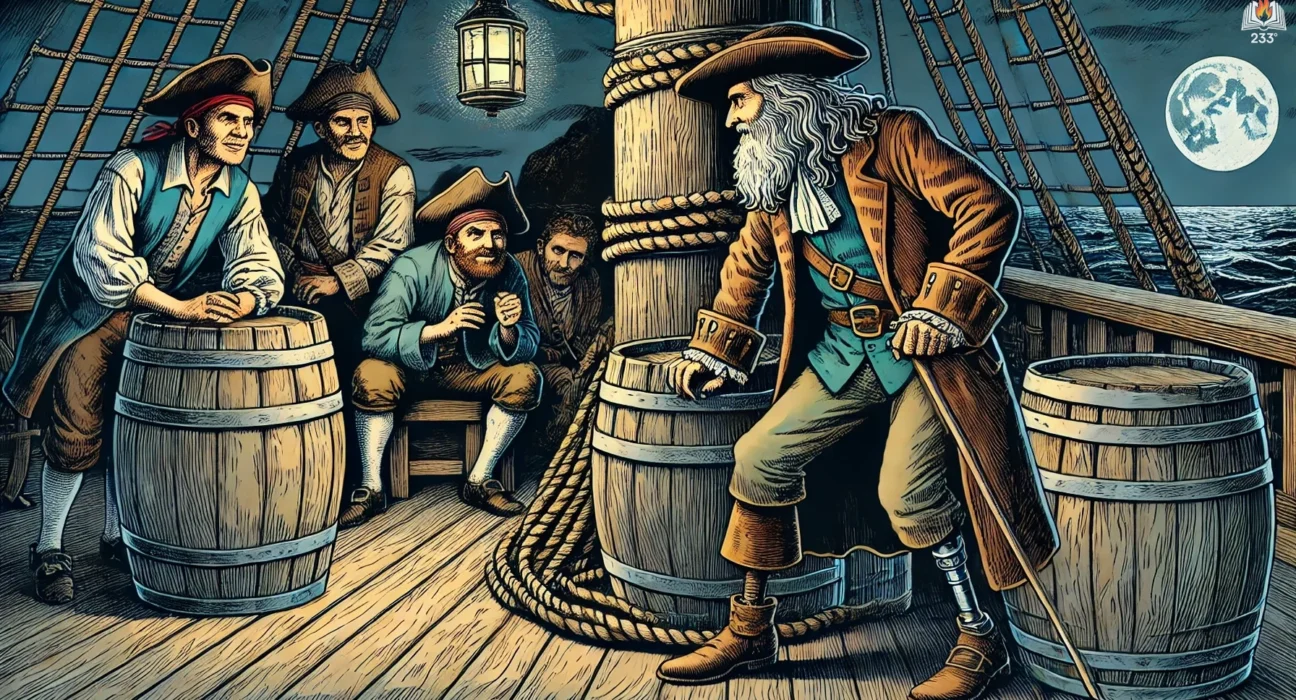Treasure Island by Robert Louis Stevenson was first published in 1883 and is a seminal work in the action and adventure genre. The story follows young Jim Hawkins as he embarks on a thrilling quest for hidden pirate treasure, encountering a host of dangerous and unforgettable characters along the way. Set during the age of pirates, the novel is widely credited for shaping popular perceptions of pirates, treasure maps, and buried loot.
Plot Summary
On the foggy coast of England, Jim Hawkins lived with his parents, running the Admiral Benbow Inn. One fateful day, a ragged, scarred seaman, known only as the captain, arrived with a sea chest, taking up residence at the inn. The captain lived in fear of a mysterious one-legged man and spent his days watching the horizon, clutching a brass telescope and drinking rum. His fears materialized when a blind man named Pew arrived, handing him a black spot—a pirate’s summons. That same night, the captain collapsed, dead of a stroke, leaving behind a chest full of treasure maps.
With his father recently dead and the inn in disarray, Jim and his mother took the map to Dr. Livesey and Squire Trelawney, men of reason and ambition. The discovery of the map ignited their imaginations—a map that pointed the way to the hidden riches of the notorious pirate Captain Flint. Soon, Squire Trelawney prepared a ship, the Hispaniola, to seek out the treasure, with Captain Smollett at the helm, a capable and cautious leader. Alongside them were Dr. Livesey and Jim, who had been swept into this adventure far beyond his quiet life at the inn.
As preparations began, Trelawney, with a naive trust, hired a crew for the journey, led by Long John Silver, a charming one-legged man who appeared both competent and friendly. Silver quickly befriended Jim, his jovial personality masking his true nature. But soon, Jim overheard a conversation that revealed Silver’s dark secret. The amiable cook was none other than Flint’s former quartermaster, and many of the crew were mutineers, intent on taking the treasure for themselves once they reached the island.
With the secret knowledge of the impending mutiny, Jim warned Captain Smollett, who had long suspected something amiss. Tensions mounted as the ship neared the island. Upon landing, Jim, filled with both curiosity and courage, ventured off on his own. While exploring the thick jungles and rugged terrain, he came across a wild, ragged figure—Ben Gunn, a marooned sailor. Ben, once a member of Flint’s crew, had been abandoned on the island for years. He had vital information: he knew the location of Flint’s treasure and offered his loyalty to Jim and his companions in exchange for a share of the loot.
Meanwhile, the crew, now split between loyalists and mutineers, began to make their moves. Silver, ever the manipulator, seized control of the mutineers, while Captain Smollett, Livesey, and Trelawney fortified themselves in an old stockade. Battle erupted between the two factions, with the pirates assaulting the stockade in hopes of overwhelming the captain and his men. The air was filled with the crack of muskets, and lives were lost on both sides, but the loyalists held their ground.
While these events unfolded, Jim continued his own daring exploits. Determined to gain an advantage, he sneaked aboard the Hispaniola, which had been taken by the pirates, and managed to cut the ship adrift. A dangerous confrontation followed, and through sheer luck and courage, Jim found himself in control of the vessel. Exhausted but triumphant, he sailed the ship to a safe harbor and made his way back to the stockade, only to find that it had fallen into Silver’s hands.
Despite the danger, Jim’s fate took an unexpected turn. Long John Silver, ever the pragmatist, did not harm the boy. Instead, he used Jim as a bargaining chip, hoping to negotiate his own survival. The remaining pirates, greedy and restless, demanded that Silver lead them to the treasure, threatening mutiny within their own ranks. Together, they embarked on the final leg of the treasure hunt, Jim a prisoner among them.
The trek to the treasure’s supposed location was filled with mounting tension. Silver, with Jim in tow, led the men deep into the island’s heart, following the map Flint had left behind. However, upon reaching the spot where the treasure was meant to be buried, the pirates found nothing but an empty hole. Flint’s fortune had vanished. Panic and fury spread through the group. The pirates, now desperate and on the verge of turning on Silver, found themselves outwitted.
Unbeknownst to the mutineers, Ben Gunn had already discovered Flint’s treasure long ago and hidden it in a secret cave. Dr. Livesey and the others, having allied with Ben, knew of this all along and were only waiting for the right moment to strike. At the height of the pirates’ confusion, Livesey and the loyalists appeared, overwhelming the remaining mutineers. Silver, ever the survivor, once again switched sides, throwing his lot in with the loyalists.
The treasure was secured, but not without cost. Many lives had been lost along the way, and the adventure had tested the mettle of all involved. The few surviving pirates were marooned on the island, left to fend for themselves, while Jim and the others made their way back to England with Flint’s fortune safely aboard the Hispaniola. Long John Silver, ever elusive, escaped during the return journey, taking with him a small portion of the treasure. His fate remained a mystery, though Jim would never forget the wily pirate who had once been both his friend and foe.
With the treasure recovered and the adventure over, Jim returned to a quieter life, though the memories of the island, the sea, and the adventures he had faced stayed with him forever. The thought of Silver’s escape lingered, but so did the knowledge that Jim had faced peril and emerged braver, wiser, and forever changed.
Main Characters
Jim Hawkins – The protagonist and narrator for much of the story. Jim is a young, courageous boy who stumbles upon a treasure map, leading him on a high-stakes adventure. Over the course of the novel, he matures from an innocent innkeeper’s son into a brave adventurer.
Long John Silver – One of literature’s most iconic pirates, Silver is a complex character who serves as the ship’s cook. Cunning, charismatic, and ruthless, Silver is both an antagonist and a mentor to Jim, playing a pivotal role in the hunt for treasure.
Dr. Livesey – A local physician and magistrate, Dr. Livesey is calm, rational, and brave. He serves as a father figure to Jim and represents the voice of reason amidst the chaos of the treasure hunt.
Captain Smollett – The strict but honorable captain of the ship, Captain Smollett is wary of the treasure hunt from the start and becomes a leader for the crew once the mutiny breaks out.
Squire Trelawney – A wealthy landowner who finances the treasure hunt, Trelawney is well-meaning but naive. His trust in the wrong people sets the stage for many of the story’s conflicts.
Theme
The Allure of Adventure and Treasure: The pursuit of hidden treasure drives the characters, reflecting human greed and the risks individuals are willing to take for wealth and adventure. The excitement of a treasure hunt is a central theme that pushes both noble and treacherous characters toward danger.
Loyalty and Betrayal: Throughout the novel, characters shift allegiances, with betrayal being a constant threat. Long John Silver embodies this, as he switches sides depending on where his advantage lies. This theme also explores the bonds that are formed and broken among the crew.
Coming of Age: Jim Hawkins’s journey from boyhood to maturity is a key theme. His experiences aboard the Hispaniola and on Treasure Island force him to confront danger, responsibility, and moral ambiguity, ultimately shaping him into a capable young man.
Morality and Survival: The novel delves into the moral dilemmas faced by the characters, particularly Jim and Long John Silver. Jim wrestles with his growing understanding of right and wrong, while Silver represents the blurred line between heroism and villainy, as his actions are often driven by survival rather than principle.
Writing Style and Tone
Stevenson’s writing style in Treasure Island is both accessible and rich with descriptive detail, capturing the adventurous spirit of the narrative. The language is straightforward but often vivid, immersing the reader in the rugged landscapes of Treasure Island and the suspenseful atmosphere aboard the ship. Stevenson employs lively dialogue to bring characters like Long John Silver to life, using their speech to reflect their personalities and moral complexities.
The tone of Treasure Island is adventurous and often filled with tension. There is a sense of youthful excitement, especially through Jim’s narration, but this is balanced by darker moments of betrayal, danger, and violence. The tone shifts from light-hearted excitement to moments of suspense and moral ambiguity, especially as Jim navigates the treacherous world of pirates.
We hope this summary has sparked your interest and would appreciate you following Celsius 233 on social media:
There’s a treasure trove of other fascinating book summaries waiting for you. Check out our collection of stories that inspire, thrill, and provoke thought, just like this one by checking out the Book Shelf or the Library
Remember, while our summaries capture the essence, they can never replace the full experience of reading the book. If this summary intrigued you, consider diving into the complete story – buy the book and immerse yourself in the author’s original work.
If you want to request a book summary, click here.
When Saurabh is not working/watching football/reading books/traveling, you can reach him via Twitter/X, LinkedIn, or Threads
Restart reading!








